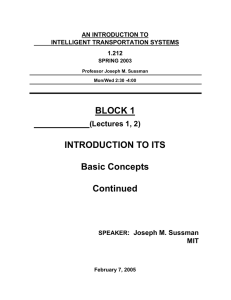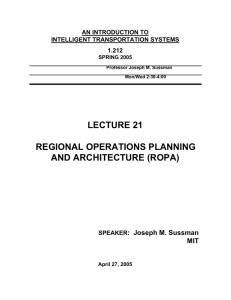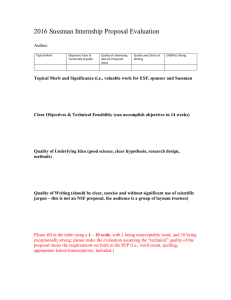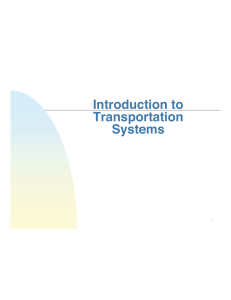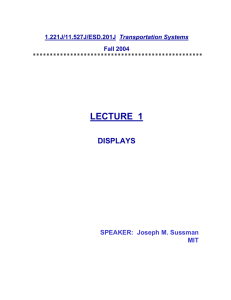BLOCK 1 INTRODUCTION TO ITS Basic Concepts Continued
advertisement
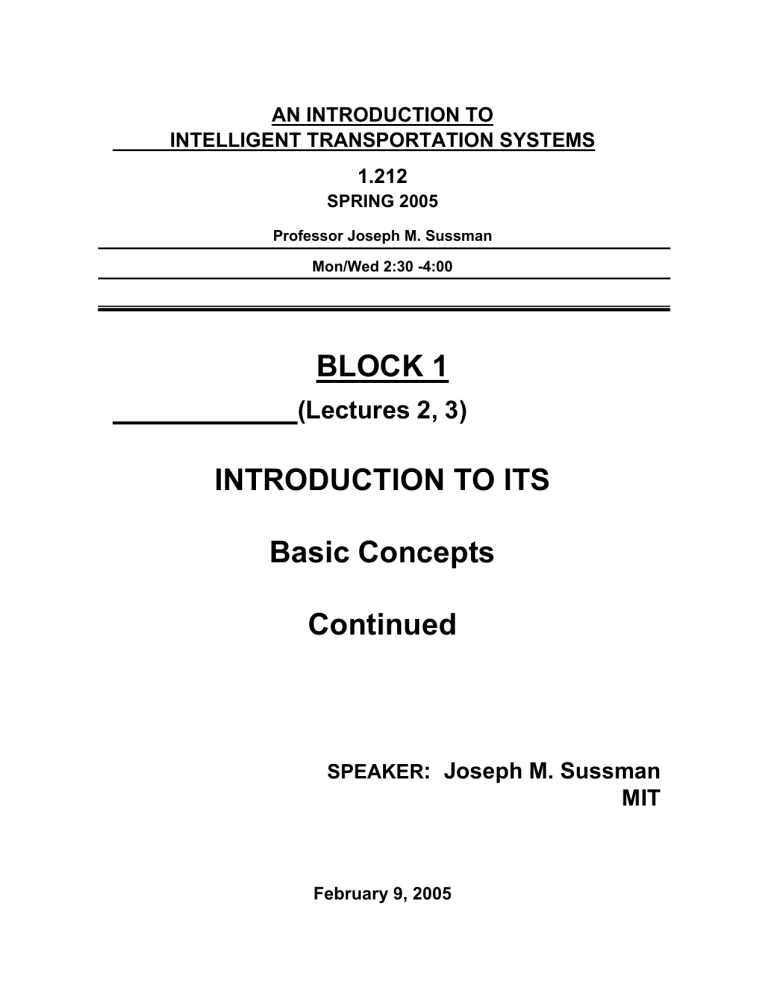
AN INTRODUCTION TO INTELLIGENT TRANSPORTATION SYSTEMS 1.212 SPRING 2005 Professor Joseph M. Sussman Mon/Wed 2:30 -4:00 BLOCK 1 (Lectures 2, 3) INTRODUCTION TO ITS Basic Concepts Continued SPEAKER: Joseph M. Sussman MIT February 9, 2005 INSTITUTIONAL ISSUES Privacy/enforcement Anti-trust Who is in Charge? Public/Private Partnership International Cooperation Tort Liability Procurement Marketplace INSTITUTIONAL ISSUES Interagency Coordination and Cooperation Metropolitan Area Traffic Management Federal and State Departments and Agencies Adaptation of Existing Posers and Organizational Forms Collaborative vs. Adversarial Approaches Public/Private Partnership Agreements INTELLIGENT TRANSPORTATION SYSTEMS (ITS) VEHICLE I NFRASTRUCTURE V I TRANSPORTATION OPERATIONS CENTER (TOC) ATMS - - ADVANCED TRANSPORTATION M ANAGEMENT SYSTEM (OPERATOR) ATIS - - ADVANCED TRAVELER INFORMATION SYSTEM (CUSTOMER) DISCUSSION: What specific actions can ATMS take to improve network performance? STATIC INFORMATION (E.G., NETWORK TOPOGRAPHY) S EMIDYNAMIC I NFORMATION (E.G., CONSTRUCTION) D YNAMIC INFORMATION ŅEÓ-INFORMATION FROM ATMS -------- ESTIMATE NETWORK STATE FIELD IN REAL-TIME E.G., VOLUMES SPEEDS QUEUES NON-ŅEÓ-INFORMATION E.G., SPOTTER AIRCRAFT STATE POLICE GENERATE NETWORK STRATEGIES ATIS --------INFORMATION TO T RAVELERS E.G., DYNAMIC ROUTING PREDICTION OF FUTURE NETWORK STATE AS F (STRATEGY ) INCLUDING ŅGUESSES Ó INFORMATION TO INDIVIDUAL VEHICLES E.G., VARIABLE MESSAGE SIGNS ABOUT TRAVELER REACTION TO ATIS ACTUAL CHANGE IN TRAVELER BEHAVIOR? S ELECT AND DEPLOY STRATEGY ITS Subsystems ATMS ATIS AVCS Advanced Transportation Management Systems Advanced Traveler Information Systems Advanced Vehicle Control Systems Network management, including incident management, traffic light control, electronic toll collection, congestion prediction and congestionameliorating strategies. Information provided to travelers pre-trip and during the trip in the vehicle. ATMS helps provide realtime network information. A set of technologies designed to enhance driver control and vehicle safety. This ranges up to Automated Highway Systems (AHS), where the driver cedes all control to the system. ITS Subsystems (Continued) CVO APTS ARTS Commercial Vehicle Operations Technologies to enhance commercial fleet productivity, including weigh-inmotion (WIM), preclearance procedures, electronic log books, interstate Advanced Public Transportation Systems coordination. Passenger information and technologies to enhance system operations, including fare collection, intramodal and intermodal transfers, scheduling, headway control. Advanced Rural Transportation Systems Mostly safety and security technologies (e.g., May-day) for travel in sparselysettled areas. TRANSPORTATION AND CHANGE Our transportation system provides fundamental and basic services to society, and has done so for thousands of years. However, as we begin the 21st century, the field is subject to many changes. These transitions occur on the dimensions of technology, systems and institutions and characterize the field in its broadest sense. TRANSITIONS What are these transitions? What do they mean for the education of the “New Transportation Professional”? CLIOS Complex Large-scale Integrated Open Systems COMPLEXITY Complexity as in CLIOS (Sussman, “The New Transportation Faculty: The Evolution to Engineering Systems”, Transportation Quarterly, Summer 1999): A system is complex when it is composed of a group of related units (subsystems), for which the degree and nature of the relationships is imperfectly known. Its overall behavior is difficult to predict, even when subsystem behavior is readily predictable. Further, the time-scales of various subsystems may be very different (as we can see in transportation -- landuse changes, for example, vs. operating decisions). NESTED COMPLEXITY Policy System Physical System SUMMARY OF TRANSITIONS FROM TO 1. C APITAL P LANNING M ANAGEMENT AND O PERATIONS FOCUS 2. LONG T IMEFRAMES R EAL- TIME C ONTROL 3. U RBAN S CALE P LANNING AND O PERATIONS R EGIONAL S CALE P LANNING AND O PERATIONS 4. E MPHASIS ON M OBILITY E MPHASIS ON ACCESSIBILITY ( THE T RANSPORTATION / LAND -U SE C ONNECTION ) 5. “O NE S IZE FITS ALL” S ERVICE C USTOMER O RIENTATION Q UALITY P RICING FOR S ERVICE FROM TO ALLOCATE CAPACITY BY Q UEUING ALLOCATE CAPACITY BY PRICING AGGREGATE M ETHODS FOR D EMAND PREDICTION D ISAGGREGATE M ETHODS FOR D EMAND PREDICTION 6. 7. 8. EPISODIC D ATA D YNAMICD ATA FOR FOR INVESTMENT PLANNING INVESTMENT PLANNING ( AND O PERATIONS) 9. PUBLIC FINANCING FOR INFRASTRUCTURE AND O PERATIONS 10. INFRASTRUCTURE CONSTRUCTION AND M AINTENANCEPROVIDERS PRIVATE AND PUBLIC/ PRIVATE PARTNERSHIPS FOR FINANCING OF INFRASTRUCTURE AND O PERATIONS U SING H YBRID RETURN ON INVESTMENT M EASURES N EW H IGHT ECHNOLOGY PLAYERS FROM TO S TATIC D YNAMIC O RGANIZATIONS AND INSTITUTIONAL RELATIONSHIPS O RGANIZATIONS AND INSTITUTIONAL RELATIONSHIPS 11. 12. PROFESSIONAL EMPHASIS ON D ESIGN OF PHYSICAL INFRASTRUCTURE 13. P ROFESSIONAL EMPHASIS ON T RANSPORTATION AS A COMPLEX, LARGE-S CALE, INTEGRATED, O PEN S YSTEM (CLIOS) ECONOMIC S USTAINABLE D EVELOPMENT D EVELOPMENT 14. COMPUTERS ARE “JUST A T OOL ” 15. FROM S UPPLY-S IDE PERSPECTIVE TO S UPPLY/D EMAND EQUILIBRIUM FRAMEWORK U BIQUITOUS COMPUTING AND O N T O S YSTEMS THAT N EVER REACH EQUILIBRIUM 16. FROM TO INDEPENDENT CONVENTIONAL LINKED ADVANCED INFRASTRUCTURE PROJECTS REQUIRING A S YSTEM ARCHITECTURE INFRASTRUCTURE PROJECTS 17. 18. VEHICLES AND VEHICLES AND INFRASTRUCTURE AS INDEPENDENT INFRASTRUCTURE AS ELECTRONICALLY LINKED REDUCING CONSEQUENCES OF CRASHES 19. FROM M ODAL PERSPECTIVE 20. CRASH AVOIDANCE TO INTERMODAL PERSPECTIVE AND O N T O S UPPLYCHAIN M ANAGEMENT N ARROW T HE N EW T RANSPORTATION S PECIALISTS T RANSPORTATION PROFESSIONAL Change and the Interstate Expansion of trucking industry; financial blow to railroads; deregulation “Unprecedented and Unequaled Mobility”; regional transportation concept; MPOs New urban structures; edge cities Post WWII economic expansion “Stop the highway” backlash; build vs .no-build factions Change and ITS Reinvention of logistics. New transportation players Changes in academia. New public sector partnerships at regional scale New public/private partnerships Regional Deployment: A Strategic Vision (Sussman) “The strategic vision for ITS, then, is as the integrator of transportation, communications, and intermodalism on a regional scale.” Quite different than the 1991 Strategic Plan vision! NESTED COMPLEXITY Policy System Physical System THE T-SHAPED TRANSPORTATION PROFESSIONAL BREADTH IN: ♦ TRANSPORTATION FUNDAMENTALS IN-DEPTH KNOWLEDGE ♦ TECHNOLOGY WITHIN A ♦ SYSTEMS TRANSPORTATION ♦ INSTITUTIONS SPECIALTY
